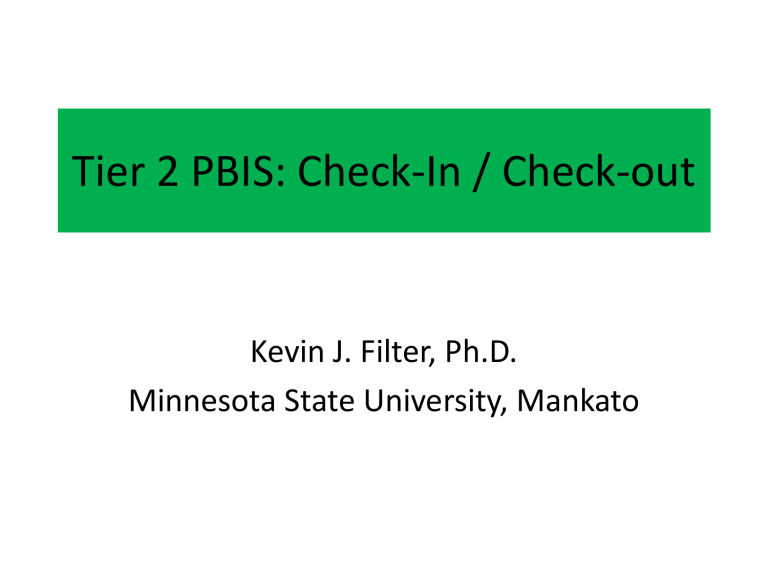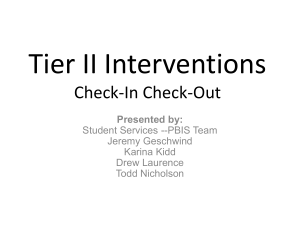Tier 2 PBIS Check-in, Check-out

Tier 2 PBIS: Check-In / Check-out
Kevin J. Filter, Ph.D.
Minnesota State University, Mankato
IMPORTANT MESSAGE
So, don’t invest in Tier 2 until Tier 1 is solid
What is Tier 2 really about?
It IS the SYSTEM that connects
Tier 1 to Tier 3
Dichotomy or Continuum?
The difference here is
NOT about
INTERVENTIONS, it’s about SYSTEMS
Interventions
Tier 2 Criteria from PBIS.org
• Continuous availability.
• Rapid access (72 hr).
• Very low effort by teachers.
• Consistent with school-wide expectations.
• Implemented by all staff/faculty in a school.
• Flexible intervention based on assessment.
Criteria from PBIS.org
(cont’d)
• Functional assessment.
• Adequate resources (admin, team), weekly meeting, plus 10 hours a week.
• Student chooses to participate.
• Continuous monitoring of student behavior for decision-making.
Are you already doing some of this?
• Most schools have some supports available for students at risk
• However, they often haven’t been systematically reviewed and connected
• So, here’s what we should be considering…
Evaluating Your CURRENT Tier 2
Supports
• Criteria from PBIS.org
• Evidence for effectiveness
– Published evidence
– Shared evidence
– Local evidence
• Re-evaluate ANNUALLY
Let’s Evaluate
• Take five minutes to review the programs available in your school for Tier 2 using the form “Evaluating Tier 2 Interventions in
School”
SELECTING STUDENTS
Office Discipline Referrals: Using existing data
– Rule of Thumb = 2 to 5 ODRs
– Not an immediate danger to self or others
• What are the problem behaviors?
– Matching behavior function to intervention
ACTIVITY / DEMONSTRATION: SWIS
STEP 1 STEP 2
• Find students with 2 to
5 ODRs
• Determine rule-out behaviors
– Major violence/aggression
• Investigate function of behaviors
OK, we’ve found them and they are in the program now – what comes next?
Keeping track of our Tier 2 students…
Using data…
Records and Decisions
• Keep records of who is participating in each program
– Name
– Progress
– Decision
• KIDS DON’T STAY IN THE PROGRAM INDEFINITELY!!!
– Follow-up AFTER they are removed from program
NEXT STEPS
• Develop criteria for moving between levels
• Develop a system to fade the Tier 2 intervention
• If Tier 2 intervention and modified Tier 2
intervention do not lead to improvements for children, then the Tier 3 process should be initiated
• Tier 3 = FBA that leads to individual behavior support plan
Some Tier 2 interventions are better than others…
Check-in / Check-out
• Strong evidence-base
– Over a dozen published studies
– Works for 67% to 75% of ALL kids
• Best for attention function but can be modified
• Designed as a Tier 2 intervention
• Can be purchased from Guilford Press as book and/or DVD
Student Recommended for BEP
Parent
Feedback
BEP Implemented
Morning
Check-In
Regular Teacher
Feedback
Behavior
Education
Program
BEP Coordinator
Summarizes Data for Decision Making
Biweekly Meeting to Assess Student
Progress
Afternoon
Check-Out
Revise
Program
Graduate
Program
Critical Features
• Morning check-in
• Daily Progress Report (point card)
• Teacher feedback throughout the day
• Afternoon check-out
• Home component
• Team management and decision-making
• Training
– Teachers
– Students
– Parent
Morning Check-In
• Students check-in with CICO manager
• Signed card from home is returned
• New card is delivered
• Point goal is reviewed
• Ensure student is ready for the day
– Materials, homework
Jason
Leanne
Juan
Kiran
Alexa
Jacey
BEP Check-In/Check-Out Record
Date:__________________ BEP Coordinator:_________________
Check-In Check-Out
Student Name Paper Pencil Notebook DPR parent copy
√ √ √ √
√ √
√ √ √
√ √
√ √ √
√ √
√
√
√
BEP Score
90
85
60
100
95
90
Student
Check-In, Check-Out Form:
Elementary School Version
Check-Out
% of Points
Earned
Goal Check-In Delivered
Contract
Signed Parent
Copy of DPR
Date
1/16
1/17
1/18
1/19
1/20
1/23
1/24
Tracking Student BEP Progress
(number = % of total daily points)
Jason Leanne Juan Kiran Alexa
88
79
95
85
100
77
45
89
0
67
95
100
0
75
100
100
100
95
77
100
85
89
95
100
80
75
85
92
90
95
78
65
77
63
85
Daily Progress Report
• One form used by all students
– Not individualized
• Connected to 3-5 positively stated PBIS behavior expectations
• Points are assigned for each behavior on a 0-2 scale
Daily Progress Report
Goals 1/5 2/6 3/7 HR 4/8
Be Respectful
2 1 0 2 1 0
Be Responsible 2 1 0
Keep Hands and
Feet to Self
2 1 0
Follow Directions 2 1 0
2 1 0
2 1 0
2 1 0
Be There –
Be Ready
TOTAL POINTS
2 1 0 2 1 0
2 1 0
2 1 0
2 1 0
2 1 0
2 1 0
2 1 0
2 1 0
2 1 0
2 1 0
2 1 0
2 1 0
2 1 0
2 1 0
2 1 0
2 1 0
HAWK Report
Date ________ Student _______________ Teacher___________________
0 = No
1= Good
2= Excellent
Class
Recess
Class
Lunch
Class
Be Safe
Keep hands, feet, and objects to self
Be
Respectful
Use kind words and actions
Be Your Personal
Best
Follow directions
Work in class
0 1 2 0 1 2 0 1 2 0 1 2
Teacher initials
0 1 2
0 1 2
0 1 2
0 1 2
0 1 2 0 1 2
0 1 2 0 1 2 0 1 2
0 1 2 0 1 2
0 1 2 0 1 2 0 1 2
Recess
Class
Total Points =
Points Possible = 50
0 1 2 0 1 2 0 1 2
0 1 2 0 1 2 0 1 2 0 1 2
Today ______________% Goal ______________%
KENNEDY CARD
Name _____________________________________________________
2
1
No
2
1
No
2
1
No
2
1
No
2
1
No
2
1
No
Materials to Class
2
1
No
2
1
No
2
1
No
2
1
No
Worked and Let
Others
Work
2
1
No
2
1
No
2
1
No
2
1
No
2
1
No
2
1
No
Followed
Directions the First
Time
2
1
No
2
1
No
Assignments:
Wow,
Assignments:
Wow,
Assignments:
Wow,
Assignments:
Wow,
Assignments:
Wow,
Assignments:
Wow,
= _____ Goal =
36
Teacher Parent
Teacher Feedback Throughout the Day
• Student is rated on behaviors during naturallyoccurring transitions
• Feedback is brief
– Verbal
– Reward success and remind how score can improve if not scored as a 2
• By using same card for all kids, teachers don’t have to “individualize” things
Afternoon Check-Out
• Check-out with CICO manager
• Review points earned relative to goal
• Deliver rewards
– Daily? Progress toward larger goals?
• CICO manager records points in database
Jason
Leanne
Juan
Kiran
Alexa
Jacey
BEP Check-In/Check-Out Record
Date:__________________ BEP Coordinator:_________________
Check-In Check-Out
Student Name Paper Pencil Notebook DPR parent copy
√ √ √ √
√ √
√ √ √
√ √
√ √ √
√ √
√
√
√
BEP Score
90
85
60
100
95
90
Home Component
• Daily Progress Report goes home to parent
• Parent verbally rewards success
– Avoid using as a punishment
• Parent signs card and gives it back to student to return to school next day
Team Management and Decision-
Making
• Team meets biweekly to review CICO program
• CICO Program Manager organizes data for meeting
• Discuss students who are not succeeding
• Plan for graduation for successful student
– Fading
Decision-Making Cont’d:
Importance of Baseline Data
• Why?
– So we know if the intervention helped
• How to do it
– Collect at least 3 to 5 days of data BEFORE the intervention begins
• Teachers score behavior but don’t provide feedback to student
Training
• Teachers
– Explain program to all teachers
– Once they know how to rate behavior they can work with any kid
• Students
– Once student starts program, schedule a meeting to review program with student
• Parents
– When a student is being considered for program, talk to parents about what the program is for and how to manage signature and home feedback process
How Is BEP Different Than Other “Behavior
Card” Interventions
• A Targeted Intervention Implemented Within a School-
Wide System of Behavior Support
– Behavior Cards typically classroom interventions
• Implemented in all settings, throughout the school day
• All teachers and staff are trained
• Students identified proactively and receive support quickly
• Team uses data for decision making to determine progress
2005 by The Guilford Press
CICO Self-Assessment
• Review what’s involved with doing a check in/ check out (CICO) program
• If you choose to invest in CICO/BEP, then this document will help with action planning
• Tier 2 is a SYSTEM that connects Tier 1 to Tier
3
• Not all schools that are interested in Tier 2 supports are ready
– Invest in Tier 1!
• Select Tier 2 programs based on evidence
• Monitor progress of all students in Tier 2
Kevin Filter
Kevin.filter@mnsu.edu
507-389-5828








